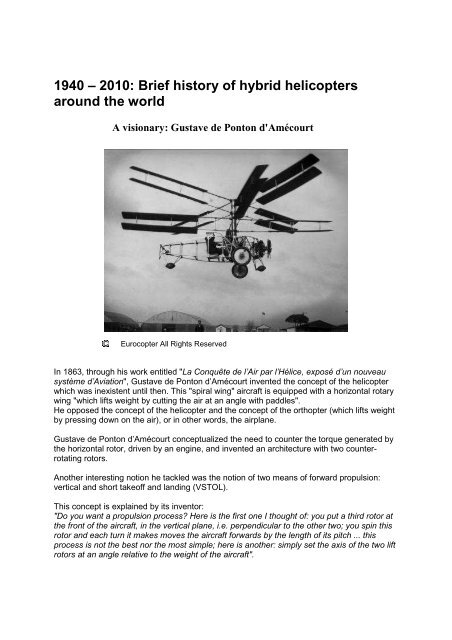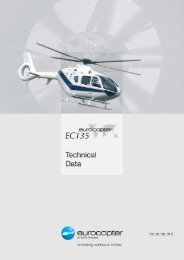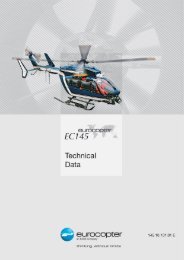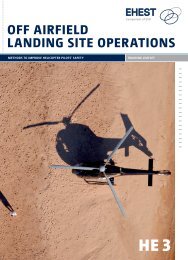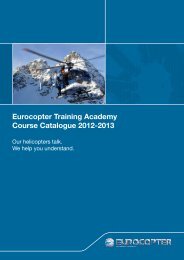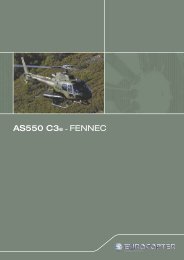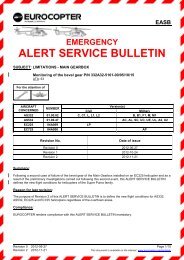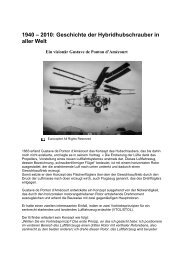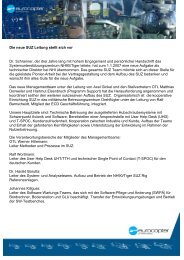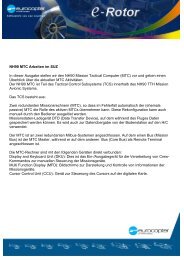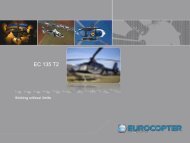1940 ? 2010: Brief history of hybrid helicopters around ... - Eurocopter
1940 ? 2010: Brief history of hybrid helicopters around ... - Eurocopter
1940 ? 2010: Brief history of hybrid helicopters around ... - Eurocopter
You also want an ePaper? Increase the reach of your titles
YUMPU automatically turns print PDFs into web optimized ePapers that Google loves.
<strong>1940</strong> – <strong>2010</strong>: <strong>Brief</strong> <strong>history</strong> <strong>of</strong> <strong>hybrid</strong> <strong>helicopters</strong><br />
<strong>around</strong> the world<br />
A visionary: Gustave de Ponton d'Amécourt<br />
<strong>Eurocopter</strong> All Rights Reserved<br />
In 1863, through his work entitled "La Conquête de l’Air par l’Hélice, exposé d’un nouveau<br />
système d’Aviation", Gustave de Ponton d’Amécourt invented the concept <strong>of</strong> the helicopter<br />
which was inexistent until then. This "spiral wing" aircraft is equipped with a horizontal rotary<br />
wing "which lifts weight by cutting the air at an angle with paddles".<br />
He opposed the concept <strong>of</strong> the helicopter and the concept <strong>of</strong> the orthopter (which lifts weight<br />
by pressing down on the air), or in other words, the airplane.<br />
Gustave de Ponton d’Amécourt conceptualized the need to counter the torque generated by<br />
the horizontal rotor, driven by an engine, and invented an architecture with two counterrotating<br />
rotors.<br />
Another interesting notion he tackled was the notion <strong>of</strong> two means <strong>of</strong> forward propulsion:<br />
vertical and short take<strong>of</strong>f and landing (VSTOL).<br />
This concept is explained by its inventor:<br />
"Do you want a propulsion process? Here is the first one I thought <strong>of</strong>: you put a third rotor at<br />
the front <strong>of</strong> the aircraft, in the vertical plane, i.e. perpendicular to the other two; you spin this<br />
rotor and each turn it makes moves the aircraft forwards by the length <strong>of</strong> its pitch ... this<br />
process is not the best nor the most simple; here is another: simply set the axis <strong>of</strong> the two lift<br />
rotors at an angle relative to the weight <strong>of</strong> the aircraft".
Part 1: The Concept<br />
According to Pr<strong>of</strong>essor J. Gordon Leischman: "A <strong>hybrid</strong> helicopter implies the use <strong>of</strong> a wing<br />
(<strong>hybrid</strong>ized lift) or the addition <strong>of</strong> a separate source <strong>of</strong> thrust for propulsion (<strong>hybrid</strong>ized<br />
thrust). The aim is to relieve the rotor <strong>of</strong> its normal lift and propulsion functions. This can be<br />
achieved by using a wing and/or auxiliary propulsion."<br />
Combining hover and high-speed horizontal flight capabilities is an old dream <strong>of</strong> airplane and<br />
helicopter designers. To cover the whole flight spectrum and all the missions <strong>of</strong> different<br />
aircraft with the same flying machine is one <strong>of</strong> the aeronautical industry's biggest challenges.<br />
Part 2: The Context<br />
<strong>Eurocopter</strong> All Rights Reserved
All Rights Reserved American Helicopter Society Summer 2006 vertiflite<br />
At the end <strong>of</strong> the Second World War, aircraft manufacturers threw themselves into the <strong>hybrid</strong><br />
adventure. Between the 1950s and the 1970s, the Western world and the former Eastern<br />
Block saw the emergence <strong>of</strong> a large number <strong>of</strong> technological demonstrators aimed at<br />
combining vertical flight and speed.<br />
Only three categories have managed to put an operational aircraft into service: the<br />
convertible category with the Bell- Boeing V22, the vectored thrust category airplane with the<br />
Harrier and its derivatives in Western Europe, and the additional vertical thrust category<br />
airplane with the YAK38 in the ex-Soviet Union.<br />
Discover a panorama <strong>of</strong> forty-five VSTOL concepts that were experimented between 1954<br />
and 1990 on the www.vtol.org website, including many experimental aircraft, the famous X-<br />
Planes.<br />
Part 3: The Concept<br />
During the cold war period, the Soviet Union was the leader in terms <strong>of</strong> aeronautics and in<br />
particular regarding new concepts. However, Europe did not remain totally absent from this<br />
market, notably in the field <strong>of</strong> jet airplanes where many concepts were produced: the C400<br />
Avatar Volant, the C450 Coleopter, the Dornier DO31, etc.<br />
From 1950 to 1970, during this search for speed for VTOL, the tilt rotor (rotary wing)<br />
convertible aircraft triumphed from this competition.<br />
Whereas the autogyro (a rotary wing aircraft where the rotor is never driven) which had its<br />
hour <strong>of</strong> glory between the 1st and 2nd world wars thanks to the pilot Juan de la Cierva, was<br />
ousted because it did not allow hover flight.
But personalities such as Juan de la Cierva in Europe or Harold Pitcairn in the USA,<br />
contributed to technical progress thanks to their inventiveness.<br />
Part 4: Models Developed Throughout the World<br />
All Rights Reserved American Helicopter Society Summer 2006 vertiflite<br />
1938 FL-185: Anton Flettner, Germany<br />
• 12-meter-diameter 3-bladed rotor, driven in hover flight then operating as an<br />
autogyro in forward flight<br />
• Two propellers back to front on the end <strong>of</strong> an arm, providing anti-torque in hover<br />
flight and propulsion in forward flight<br />
• 140 hp (104 kW) Siemens-Halske 14A engine<br />
• Maximum weight: 900 kg
<strong>Eurocopter</strong> All Rights Reserved<br />
1945 WNF 341V4: Freidrich von Doblh<strong>of</strong>f (Wierner Neustader Flugzeugwerke), Austria<br />
• 10-meter-diameter rotor driven by blade tip jets (air/fuel mixture) which does not<br />
require anti-torque<br />
• Pusher propeller at the rear which was only ground tested; the propeller shown<br />
on the V3 & V4 models creates an airflow for flight control over the tail yaw control<br />
surfaces<br />
• 140 hp (104 kW) BMW-Bramo Sh 14A engine<br />
• Maximum weight: 640 kg<br />
• At the end <strong>of</strong> the war, the V4 and von Doblh<strong>of</strong>f embarked for the USA where von<br />
Doblh<strong>of</strong>f participated actively in the McDonnell XV-1; a member <strong>of</strong> his team,<br />
Theodor Laufner, headed to France to participate in the development <strong>of</strong> the SO<br />
1221 Djinn "cold" jet rotor drive. Finally, August Stepan, another engineer from<br />
the von Doblh<strong>of</strong>f team, but also a WNF342 pilot, joined Fairey Aviation in Great<br />
Britain to develop a jet rotor on the Jet-Gyrodyne and the Rotodyne.
All Rights Reserved American Helicopter Society Summer 2006 vertiflite<br />
1947-1949 Gyrodyne: Fairey, Great Britain<br />
• Sixteen-meter-diameter driven rotor operating with a low collective pitch without<br />
reaching the autogyro mode<br />
• One pusher propeller on the right<br />
• 5.08-meter-span wing<br />
• Maiden flight on the Fairey airfield at White Waltham on December 7, 1947, at<br />
the hands <strong>of</strong> Squadron Leader Basil Arkell<br />
• Powered by a 520 hp (388 kW) 9-radial-cylinder Alvis Leonides engine<br />
• Maximum weight: 2180 kg<br />
• World speed record over 3 km on June 28, 1948, with a speed <strong>of</strong> 108 kt
All Rights Reserved American Helicopter Society Summer 2006 vertiflite<br />
1949 CGA -2a: Gyrodyne, Gyrodyne Company <strong>of</strong> America USA<br />
• First compound helicopter to fly in the USA<br />
• Two coaxial two-bladed rotors driven by a 450 hp Pratt & Whitney R-985 piston<br />
engine<br />
• Two pusher propellers each driven by a 100 hp Continental piston engine, and<br />
providing yaw control
All Rights Reserved American Helicopter Society Summer 2006 vertiflite<br />
1953 SNCASO FARFADET France<br />
• 11.2-meter-diameter three-bladed rotor driven by blade tip jets (air/fuel mixture) at low<br />
speeds, then autogyro operation<br />
• Constant-speed Ratier two-bladed pusher propeller mounted at the front<br />
• Powerplant: for the rotor, a 275 hp (202 kW) Arius I turbocharger located behind the<br />
cabin supplied the compressed air; for the propeller, a 275 hp (202 kW) Artouste II<br />
turbo-prop engine<br />
• Turbo-prop engine gas deflection valves for yaw control, mounted at the end <strong>of</strong> the<br />
tail<br />
• 6.3-meter-span wing<br />
• Maximum weight: 1,500 kg<br />
• Maiden flight on the Villacoublay airfield on May 7, 1953, at the hands <strong>of</strong> Jean<br />
Dabos.
All Rights Reserved American Helicopter Society Summer 2006 vertiflite<br />
1954-1956 Jet-Gyrodyne: Fairey, Great Britain<br />
• Second prototype <strong>of</strong> the Gyrodyne modified to incorporate a rotor driven by blade tip<br />
jets (air/fuel mixture) and demonstrator for the future Rotodyne<br />
• Two 3250 hp (2300 kW) Napier Eland E.L turbo-shaft engines driving the pusher<br />
propellers and two compressors supplying compressed air to the blades.<br />
• 14.2-meter-span wing.<br />
• Maximum weight: 14,900 kg.<br />
• Maiden flight on November 6, 1957, at the hands <strong>of</strong> Ron Gellatly and John Morton.<br />
• World speed record for convertibles, reaching 167 kt on a 100 km circuit on January<br />
5, 1959.
All Rights Reserved American Helicopter Society Summer 2006 vertiflite<br />
1954-1957 McDonnell XV-1: McDonnell, USA<br />
• 9.4-meter-diameter three-bladed rotor driven by blade tip jets (air/fuel mixture),<br />
operating as an autogyro in forward flight<br />
• Two-bladed pusher propeller located behind the fuselage<br />
• Two small tail rotors which ensure yaw control at low speed<br />
• 550 hp (405 kW) R-975-19 Continental piston engine driving the pusher propeller<br />
and two compressors which supply compressed air to the blades<br />
• Maximum weight: 2,180 kg<br />
• Maiden flight on July 14, 1954<br />
• First rotary wing aircraft to reach 200 mph (173 kt) on October 10, 1956
All rights Reserved Acknowledge to Agusta Westland<br />
1957-1962 Rotodyne Y model: Fairey then Westland, Great Britain<br />
• Demonstrator for the Rotodyne Z model, designed to carry 57 to 70 passengers<br />
and with a maximum weight <strong>of</strong> 31,000 kg<br />
• 27.5-meter-diameter four-bladed rotor driven by blade tip jets (air/fuel mixture),<br />
operating as an autogyro in forward flight<br />
• Two four-bladed pusher propellers with variable pitch, also providing yaw control<br />
at low speed<br />
• Two 3,250 hp (2,300 kW) Napier Eland E.L. turbo-shaft engines driving the<br />
pusher propellers and two compressors supplying compressed air to the blades<br />
• 14.2-meter-span wing<br />
• Maximum weight: 14,900 kg<br />
• Maiden flight on November 6, 1957, at the hands <strong>of</strong> Ron Gellatly and John Morton<br />
• World speed record for convertibles, reaching 167 kt on a 100 km circuit on<br />
January 5, 1959.
All Rights Reserved American Helicopter Society Summer 2006 vertiflite<br />
1961 KA-22 Vintokryl: Kamov, USSR<br />
• Two 22.5-meter-diameter four-bladed wing tip rotors<br />
• Two four-bladed pusher propellers mounted on the wing tips<br />
• Two 6,500 hp (4,800 kW) Soloviev D-25VK turbo-shaft engines, pod mounted on the<br />
wing tips, driving the rotors and the pusher propellers<br />
• 25-meter-span wing<br />
• Maximum weight: unknown, aircraft capable <strong>of</strong> carrying 80 passengers or a 16,500 kg<br />
payload<br />
• Maiden flight: April 1960<br />
• World speed record over a 15 - 25 km circuit on October 7, 1961: 192 kt
All Rights Reserved American Helicopter Society Summer 2006 vertiflite<br />
1962-1969: Bell 533 model: Bell Helicopter Company, USA<br />
• Research helicopter developed on the basis <strong>of</strong> a Bell YH-40 which is equipped<br />
with various rotors (approximately 13-meter-diameter two-bladed, three-bladed<br />
and four-bladed rotors), with an auxiliary propulsion and/or a wing<br />
• 1400 shp (1030 kW) Lycoming T53-L-13 turbo-shaft engine driving the rotor<br />
• In the auxiliary propulsion versions: use <strong>of</strong> two 420 daN thrust Continental J69-T-<br />
9 jet engines, then two 770 daN thrust J69-T-29 jet engines and finally two 1500<br />
daN thrust Pratt & Whitney jet engines<br />
• In the winged version: addition <strong>of</strong> an 8-meter-span wing<br />
• Maiden flight on August 10, 1962<br />
• Reached a speed <strong>of</strong> 275 kt on April 15, 1969
All Rights Reserved American Helicopter Society Summer 2006 vertiflite<br />
1962 – 1966 Piasecki 16 H- 1 Pathfinder: Piasecki Aircraft Corporation, USA<br />
• 12.5-meter-diameter three-bladed rotor<br />
• 1.7-meter-diameter shrouded three-bladed pusher propeller equipped with the "Ring<br />
Tail" system, providing anti-torque, fore-and-aft pitch and yaw control through<br />
propeller thrust deflection<br />
• One 550 hp (405 kW) United Aircraft <strong>of</strong> Canada PT6B-2 turbo-shaft engine, driving<br />
the rotor and the shrouded propeller<br />
• Maiden flight: February 21, 1962<br />
• Speed attained: 170 mph/275 km/h
All Rights Reserved American Helicopter Society Summer 2006 vertiflite<br />
1963-1965 Kaman UH-2 Compound: Kaman, USA<br />
• Research aircraft comprising a Kaman Seasprite UH-2A single-engine aircraft<br />
with an additional auxiliary jet engine and/or a wing<br />
• Rotor and rotor drive: standard UH-2A (13-meter-diameter four-bladed rotor and<br />
1,500 shp (1,100 kW) General Electric T58-8F turbo-shaft engine)<br />
• General Electric YJ85, pod mounted on the right, with approximately 1,100 daN <strong>of</strong><br />
thrust<br />
• 11-meter-span wing<br />
• Maiden flight: November 26, 1963
All Rights Reserved American Helicopter Society Summer 2006 vertiflite<br />
1964 Lockheed XH-51A Compound: Lockheed, USA<br />
• Demonstrator for a compound helicopter obtained from two XH-51As (No.<br />
151263) equipped with a wing and a jet engine<br />
• 10.7-meter-diameter gyroscopic rigid four-bladed rotor from the original XH-51A<br />
• 1.8-meter-diameter tail rotor<br />
• 375 kW Pratt & Whitney PT6B-9 turbo-shaft engine for the rotor drive<br />
• 1180 daN thrust Pratt & Whitney J60-P-2 jet engine for the additional propulsion<br />
• 5-meter-span wing<br />
• Maximum weight: 2,000 kg<br />
• Maiden flight: April 10, 1965<br />
• Un<strong>of</strong>ficial record for a helicopter on June 19, 1967: 263 kt
1964 NAGLER VG-1 VERTIGO: Napier Helicopter Company, USA<br />
• Wingless fuselage <strong>of</strong> a Piper Colt to which a Sud-Aviation Djinn helicopter rotor is<br />
added ("cold" jet drive).<br />
• Standard Piper Colt propeller at the front.<br />
• 108 hp (80 kW) Piper Colt standard Lycoming piston engine for the propeller drive,<br />
and a Garett turbocompressor for the rotor compressed air supply.<br />
• Low speed yaw control provided by blowing the compressor jets at the vertical fin.<br />
• Maiden flight in January 1964.<br />
All Rights Reserved American Helicopter Society Summer 2006 vertiflite<br />
1965-1966 VFW H2: Vereinigte Flugtechnische Werke, Germany<br />
• Demonstrator aircraft for the VFW H3-E<br />
• 6-meter-diameter two-bladed rotor, driven by blade tip jets through combustion <strong>of</strong><br />
an air/fuel mixture in hover flight, and by "cold" jet (only compressed air) in<br />
forward flight<br />
• Pusher propeller behind the pilot<br />
• 72 hp (53 kW) Mc Culloch piston engine driving the pusher propeller and the air<br />
compressor for the rotor<br />
• Maximum weight: 270 kg
• Maiden flight: April 30, 1965<br />
• The H3-E model with the fuselage and cabin capable <strong>of</strong> carrying one pilot and two<br />
passengers did not fly in the compound version, the two shrouded propellers<br />
installed on the sides <strong>of</strong> the fuselage were never installed for flight.<br />
All Rights Reserved American Helicopter Society Summer 2006 vertiflite<br />
1965-1967 NH-3A compound 61F: Sikorsky, USA<br />
• Research aircraft developed on the basis <strong>of</strong> a Sikorsky SH-3A Sea king, with the<br />
fuselage modified to make it more aerodynamic by removing the fairing and floats<br />
and adding auxiliary jet engines and/or a wing<br />
• 19-meter-diameter five- or six-bladed rotor<br />
• Two 1250 shp (920 kW) General Electric T59-GE-8Bs for main rotor and tail rotor<br />
drive<br />
• Two 1300 daN thrust Pratt & Whitney J-60P-2 jet engines for the auxiliary<br />
propulsion<br />
• 10-meter-span wing<br />
• Maximum weight: 8,600 kg<br />
• Maiden flight: May 21, 1965
All Rights Reserved American Helicopter Society Summer 2006 vertiflite<br />
1967-1972 AH56-A Cheyenne: Lockheed, USA<br />
• Ten development prototypes were manufactured for a two-crew attack helicopter<br />
for the US Army<br />
• 15.6-meter-diameter Lockheed gyroscopic rigid four-bladed rotor<br />
• 3-meter-diameter four-bladed tail rotor<br />
• 3-meter-diameter Hamilton-Standard three-bladed pusher propeller<br />
• 8-meter-span wing<br />
• 2,500 kW General Electric T64-GE-16 turbo-shaft engine for rotor and pusher<br />
propeller drive<br />
• Maiden flight on September 21, 1967, at the hands <strong>of</strong> Don Segner<br />
• The Cheyenne was the compound helicopter which came the closest to being put<br />
into service. When the program was stopped on August 9, 1972, the Cheyenne<br />
had reached a speed <strong>of</strong> 215 kt. Its high-speed maneuverability was remarkable<br />
and especially it had an exceptional weapons system for the period; the<br />
forerunner <strong>of</strong> the weapons systems on modern <strong>helicopters</strong> such as the AH64<br />
Apache or the Tiger.
1975 BO105 HGH: MBB, Germany<br />
• Research aircraft for studying high speeds, produced on the basis <strong>of</strong> a BO105 by<br />
adding fairings on the rotor head and at the rear <strong>of</strong> the fuselage, and by reducing<br />
the height <strong>of</strong> the landing gear and adding a wing<br />
• 9.8-meter-diameter AGBI rigid four-bladed rotor<br />
• BO150 standard tail rotor with 6-meter-span wing<br />
• Aircraft reached 220 kt<br />
<strong>Eurocopter</strong> All Rights Reserved
<strong>Eurocopter</strong> All Rights Reserved<br />
1975-1977 Gazelle SA349 Z: Aérospatiale, France<br />
• Research aircraft produced on the basis <strong>of</strong> a Gazelle SA342, equipped with a<br />
wing in order to study the increased maneuverability provided by the wing<br />
• 10.5-meter-diameter Gazelle standard three-bladed rotor<br />
• First helicopter equipped with the Fenestron fan-in-fin anti-torque rotor<br />
• 640 kW Astazou XIV M turbo-shaft engine driving the main rotor and the<br />
Fenestron
All Rights Reserved American Helicopter Society Summer 2006 vertiflite<br />
1978-1988 RSRA: Sikorsky, USA<br />
• Research aircraft used to study different types <strong>of</strong> rotors (Rotor System Research<br />
Aircraft) and equipped with a wing and additional propulsion<br />
• S-61 five-bladed standard rotor<br />
• S-61 standard tail rotor<br />
• 13-meter-span wing<br />
• Two 1040 kW General Electric T58-GE-5 turbo-shaft engines<br />
• Two 4400 daN thrust General Electric TF34-GE-400A jet engines for the<br />
propulsion<br />
• Maiden flight <strong>of</strong> the compound version on April 10, 1978<br />
• The S-72 RSRA is one <strong>of</strong> the few compound <strong>helicopters</strong> that was not made in<br />
view <strong>of</strong> high speeds
All Rights Reserved American Helicopter Society Summer 2006 vertiflite<br />
1978-1980 XH-59A: Sikorsky, USA<br />
• XH-59A (Sikorsky S69) demonstrator, manufactured to study the ABC (Advancing<br />
Blade Concept) rotor which, in its compound version, was equipped with<br />
additional jet engines<br />
• Two 12-meter-diameter ABC rigid counter-rotating rotors<br />
• Two 1400 kW Pratt & Whitney PT-6T-3 TwinPack turbo-shaft engines<br />
• Two 1300 daN thrust Pratt & Whitney J60-P-3A jet engines for the propulsion<br />
• Maiden flight: end <strong>of</strong> 1978
All Rights Reserved American Helicopter Society Summer 2006 vertiflite<br />
2007 XH-49A SpeedHawk: Piasecki (based on the Sikorsky SeaHawk), USA<br />
• Technological demonstrator for the VTDP (Vectored Thrust Ducted Propeller)<br />
concept, modern version <strong>of</strong> the Ring Tail which flew on the Piasecki 16H<br />
Pathfinders I and II. Designed on the basis <strong>of</strong> a Sikorsky YSH-60 Seahawk,<br />
equipped with a wing and a ducted propeller with vectored thrust<br />
• 16.4-meter-diameter SeaHawk standard rotor.<br />
• MT five-bladed propeller - Vectored Thrust Ducted Propeller providing anti-torque,<br />
propulsion, yaw control and fore-and-aft pitch balance<br />
• Piper Aerostar wing with a span reduced to approximately 9 meters<br />
• Two 1250 kW General Electric T700 turbo-shaft engines from the SeaHawk,<br />
driving the rotor and the VTDP; in phase II <strong>of</strong> the program it was scheduled to add<br />
a third turbo-shaft engine (440 kW Rolls Royce 250C30) dedicated to propulsion<br />
• Maximum weight: 10,000 kg<br />
• Maiden flight on June 29, 2007, at the hands <strong>of</strong> S. Schellberg
All Rights Reserved American Helicopter Society Summer 2006 vertiflite<br />
2008 X2: Sikorsky, USA<br />
• Technological demonstrator for the Sikorsky ABC rotor, subsequent to the XH-<br />
59A<br />
• Two 8-meter-diameter ABC counter-rotating four-bladed rotors<br />
• One six-bladed pusher propeller<br />
• One 1340 kW LHTEC T-800 turbo-shaft engine, driving the rotors and the pusher<br />
propeller<br />
• Maximum weight: 3,600 kg<br />
• Maiden flight on August 27, 2008, at the hands <strong>of</strong> K. Bredenbeck<br />
• On September 15, <strong>2010</strong>, the X2 reached a speed <strong>of</strong> 250 kt.


